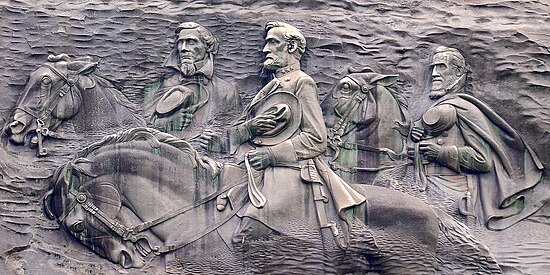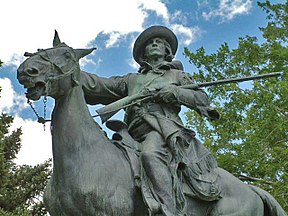Henry Augustus Lukeman
This article needs additional citations for verification. (January 2011) |
This article's factual accuracy may be compromised due to out-of-date information. (September 2015) |

Henry Augustus Lukeman (January 28, 1872 – April 3, 1935) was an American sculptor, specializing in historical monuments. Noted among his works are the World War I monument in Prospect Park, Brooklyn, the Kit Carson Monument in Trinidad, Colorado and the Stone Mountain Confederate Memorial in Georgia.
Biography
Early life and education
Henry Augustus Lukeman was born on January 28, 1872,[citation needed] in Richmond, Virginia,[1][2][page needed] and introduced to sculpting at age 10 at a boys' club miniature workshop, working in clay and wood from ages 10 to 13.[citation needed] He then became a pupil of sculptor Launt Thompson;[1] he remained with him until age 16,[3][verification needed] and followed this training by an apprenticeship at the foundry of Jno. Williams, Inc. (until he was 19).[citation needed] Then, for several years,[when?] he studied terra cotta and architectural modeling for building and exterior decorations while in the evening studying life drawing (at the Cooper Union and the National Academy of Design in New York).[citation needed]
American works
This section needs additional citations for verification. (September 2015) |
When the construction began of the 1893 World's Columbian Exposition, Lukeman superintended the enlarging of some important works at the instruction of such principals as Daniel Chester French,[citation needed] (e.g., Statue of the Republic).[1] Following that he went to Europe and worked under Jean-Alexandre-Joseph Falguiere, at the Beaux Arts, in Paris.[1][4][verification needed] When he returned to New York he studied under Daniel Chester French, and acted as his assistant,[1] then created his own studio in New York.[when?][citation needed]
His independent work began there, and included "monuments, portrait busts and statues, bas-reliefs, ornamental sculpture," which have been described as being "architecturally effective and often remarkable in conception."[1] A list of his American and Canadian commissions and other important public sculpture works are given below.
A seminal work of Lukeman was Stone Mountain in Atlanta, Georgia, where he designed and sculpted the monument after removing Gutzon Borglum's work (the original commissionee, who had resigned).[citation needed] When funding ran out in the advent of the Great Depression, he continued to pay the craftsmen until his own means fell short.[citation needed] The carving remained incomplete for decades until sculptor Walker Hancock and chief carver Roy Faulkner completed an edited version of the Lukeman design in 1970;[citation needed] located 400 feet (120 m) above ground, and lacking the originally intended legs on the horses, it measures 190 feet (58 m) by 90 feet (27 m), and is recessed 42 feet (13 m).[citation needed]
Lukeman died in New York on April 3, 1935, aged 65,[citation needed] leaving his wife, formerly, Helen Bidwell Blodgett.[citation needed]
Honors and awards
Lukeman's work was recognized by the Henry Street Settlement,[when?][citation needed] and he was given an honorary Doctor of Humane Letters from Dickinson College.[when?][citation needed]
Public sculptures
Dated entries

The following entires, whose dates of execution are known, are ordered according to date, earliest to latest:
- Manu, the Law Giver of India, 1899, on the Appellate Division Courthouse of New York State, New York City.[1]
- Music (Festival Hall) and another decorative sculpture (Electrical Building), at the Saint Louis Exposition, 1904, Saint Louis, Missouri;[1] awarded a medal.[clarification needed][citation needed]
- Hebrew Law Giver, Hebrew Psalmist, Hebrew Apostle, and Hebrew Prophet (4 figures, facade),[5][1] 1907-1909,[citation needed] the Brooklyn Institute of Arts and Sciences, New York.
- The Straus Memorial in Straus Park, Manhattan, New York City, 1915;[citation needed] dedicated to Ida and Isidor Straus, who lost their lives on the RMS Titanic.[6][better source needed]
- Pulitzer Prize gold medal (with Daniel Chester French), 1918.[7]
- The Prospect Park Memorial, 1921, a World War I monument, in Prospect Park, Brooklyn.[8]
- The Soldiers and Sailors Monument, 1923, Pittsfield, Massachusetts;[citation needed] refurbished, with presentation, Memorial Day 2010.[citation needed]
- Confederate Memorial Carving of President Jefferson Davis, and Generals Robert E. Lee and Thomas J. "Stonewall" Jackson (and horses, Blackjack, Traveller, and Little Sorrel), Stone Mountain, DeKalb County, Georgia, 1925-1928;[citation needed] preceded in this project by Gutzon Borglum,[citation needed] and followed by Walker Hancock.[citation needed]

Undated entries
This section needs additional citations for verification. (September 2015) |

The following entires, whose dates of execution are unknown, are ordered alphabetically by the subjects surname or place name:
- Francis Asbury Equestrian Sculpture, Washington, D.C.[citation needed]
- Francis Asbury Statue, Madison, New Jersey.[citation needed]
- Daniel Boone bas-relief portrait, Paris, Kentucky.[citation needed]
- Kit Carson Monument in Trinidad, Colorado;[1] figure of Carson; sculptor Frederick Roth executed the horse.[citation needed]
- Lieutenant Cushing, on the Dewey Arch, New York, New York.[citation needed]
- Custom House, Columbus, New York.[citation needed]
- Ulysses S. Grant Memorial, San Diego, California.[citation needed]
- Major General David McM. Gregg equestrian statue, Reading, Pennsylvania.[citation needed]
- Joseph Henry, professor, Princeton University, Princeton, New Jersey.[1]
- Robert Livingston, Saint Louis, Michigan.[1]
- President William McKinley Statue, Adams, Massachusetts.[1]
- President William McKinley Statue, Toledo, Ohio.[citation needed]
- Memorial to the Women of the Confederacy, Raleigh, North Carolina.[citation needed]
- National Sculpture Society Seal.[citation needed]
- Pan American Exposition sculpture, in Buffalo, New York.[citation needed]
- James K. Patterson, early president of the University of Kentucky, Lexington, Kentucky.[citation needed]
- President Franklin Pierce, New Hampshire State Capitol, Concord, New Hampshire.[citation needed]
- Royal Bank of Canada headquarters, four colossal statues, Montreal, Quebec, Canada.[1]
- General William Shepard, Westfield, Massachusetts.[citation needed]
- Soldiers and Sailors Monument, Public Square, Watertown, New York.[citation needed]
- Soldiers’ Monument, Somerville, Massachusetts.[1]
- Elisha Yale, at Gloversville, New York.[citation needed]
References
- ^ a b c d e f g h i j k l m n o Colby, Frank Moore & Talcott Williams, eds. (1915). "Lukeman, Henry Augustus (1870–)". New International Encyclopedia (2nd ed.), Vol. 14, p. 461, New York: Dodd, Mead, available at [1], accessed 12 September 2015.
- ^ McGlauflin, Alice Coe, ed. (1937), Who’s Who in American Art: Volume II, 1938-1939, The Washington D.C.: American Federation of Arts.[page needed]
- ^ National Sculpture Society (1929), ‘’Contemporary American Sculpture: The California Palace of the Legion of Honor, Lincoln Park, San Francisco, April to October MCMXXIX" [catalog], p. 152, New York, NY: Kalkhoff Co.[verification needed] Quote: "Issued for the exhibition held by the National [S]culpture [S]ociety in co-operation with the trustees of the California [P]alace of the Legion of [H]onor." See entry 2724 at [2], accessed 12 September 2015.
- ^ National Sculpture Society (1929), ‘’Contemporary American Sculpture’’, p. 213, National Sculpture Society: New York, NY.[verification needed]
- ^ Anon. (1910), "The Museum Statues," in The Museum News, Vol. 6, no. 3 (December), pp. 34-36, Brooklyn, NY: Museum of the Brooklyn Institute of Arts and Sciences, see [3], accessed 12 September 2015.
- ^ Gibberd, Ben (2006). "Street Level, Upper West Side: Taking Refuge Beneath Memory's Gaze". The New York Times (November 19). Retrieved 12 September 2015. Note: Citation describes the park and its dedication, but does not discuss the work of Lukeman.[better source needed]
{{cite news}}: Cite has empty unknown parameter:|1=(help)CS1 maint: postscript (link) - ^ The Pulitzer Prize Board (2015). "The Medal: Pulitzer Gold," see [4], accessed 12 September 2015.
- ^ NYC Parks (2015), "Prospect Park: Prospect Park War Memorial," see [5], accessed 12 September 2015.
![]() This article incorporates text from a publication now in the public domain: Gilman, D. C.; Peck, H. T.; Colby, F. M., eds. (1905). "Lukeman, Henry Augustus (1870–)". New International Encyclopedia (1st ed.). New York: Dodd, Mead.; reflected in largest part by the inline references to Colby & Williams, (1915), New International Encyclopedia (2nd ed.), op. cit.
This article incorporates text from a publication now in the public domain: Gilman, D. C.; Peck, H. T.; Colby, F. M., eds. (1905). "Lukeman, Henry Augustus (1870–)". New International Encyclopedia (1st ed.). New York: Dodd, Mead.; reflected in largest part by the inline references to Colby & Williams, (1915), New International Encyclopedia (2nd ed.), op. cit.
Further reading
- David Bernard Dearinger, ed. (2004) Paintings and Sculpture in the Collection of the National Academy of Design: 1826-1925 (Volume 1), pp. 123f, New York, NY: Hudson Hills, ISBN 1555950299, see [6] and [7], accessed 12 September 2015.
- Anon. (1935), "Obituary: [Henry Augustus] Lukeman is Dead, A Noted Sculptor; Succeeded Borglum as Designer of Stone Mountain Memorial to Confederacy," The New York Times (online), Thursday April 4, 1935, see [8], accessed 12 September 2015.[Subscription required]
- The Smithsonian (2015), "Research Collections, L: Henry Augustus Lukeman papers, circa 1891-1935 (summary)," Smithsonian Archives of American Art, (online), see [9], accessed 12 September 2015. Collection size, 0.50 linear feet (0.15 m), Full access at the Washington, D.C., Research Center.
- The Times-Dispatch, Richmond, Virginia, May 10, 1903.[full citation needed]
